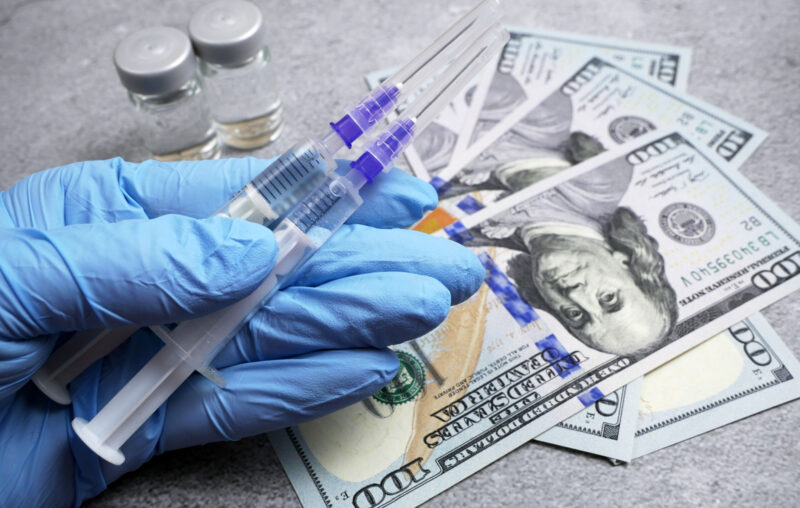Why Pfizer and Moderna Are Suddenly Charging 500 Percent More for COVID Shots

During a 2021 earnings call with stockholders, Pfizer Chief Financial Officer Frank D’Amelio discussed how the company was using “pandemic pricing” to charge $19.50 per COVID-19 vaccine dose, a product it expected to make $15 billion on in 2021.
“[There’s] significant opportunity for those margins to improve once we get beyond the pandemic environment that we’re in,” D’Amelio said.
He wasn’t joking.
When the Associated Press rolled out a story a couple weeks ago announcing that Americans can now receive an updated COVID shot, buried in the twelfth paragraph was this little nugget.
“The list price of a dose of each shot is $120 to $130, according to the manufacturers,” the AP reported.
Pfizer and its German partner BioNTech set list prices at the bottom end of that; Moderna’s price was a bit higher.
The quadrupling in pricing from two years ago has received little media attention, but some have noticed and are not happy. Kathryn Edwards, a professor of pediatrics and infectious diseases at the Vanderbilt University School of Medicine, summed up her thoughts on the price increase in two words: “pretty awful.”
The Washington Post reports that some clinics are charging up to $150 a shot, and some patients are paying out of pocket (even though under federal law COVID vaccines are required to be covered by both public and private insurers).
“That’s ridiculous,” Jenna Vallejo, chief operating officer at a pediatric hospital in Maryland told the paper.
A spokesperson for Pfizer announced the pricing is “consistent with the value delivered.”
Pfizer’s Pricing Problem
People are unhappy about what Pfizer is charging, but it bears asking: What should Pfizer be charging for its vaccine?
Warren Buffett has famously said, “Price is what you pay; value is what you get.”
The quote is helpful because it’s a reminder that price and value are not the same thing. Value is subjective. It’s not determined by how much labor goes into a product, or how many resources.
Prices work differently. In a free market, buyers and sellers freely make decisions on a daily basis that help determine the prices of everything from bacon and peanut butter to stocks and iPhones.
Vaccines work a bit differently, of course.
For starters, as mentioned, most consumers will not have to pay anything for the vaccine. In most cases, a third-party — public or private insurance — will be picking up the tab. In other cases, governments purchase vaccines directly from manufacturers at a negotiated price (more on that in a minute).
All of this means that Pfizer has a lot of leeway in the price it chooses to charge for its vaccine — especially when one considers almost all rival competitors have been sidelined by the Food and Drug Administration.
But there’s more to the story.
No More Coercion
Pfizer’s financial reporting shows that in 2021 revenue was $81.3 billion, roughly double its revenue in 2020. In 2022, total revenues surged even higher, surpassing $100 billion. In 2022, the vaccine accounted for about $38 billion (billion with a B) of Pfizer’s revenue, despite its relatively low price.
Things have changed since then. For much of 2021 and 2022, Pfizer was in the catbird seat. Governments were coercing people to get vaccinated. If you weren’t vaccinated, you could get fired. Or kicked out of school. Or denied entry to a restaurant or concert.
The use of government force (and threats of force) artificially raised the demand of Pfizer’s product, which juiced profits. But those days are mostly over. Politicians are no longer talking about making Americans get vaccinated, either because the policy proved too polarizing and unpopular or because public officials have finally conceded that the vaccines don’t prevent COVID infection.
Whatever the case, the lack of coercion will mean a much lower demand for COVID vaccines. Indeed, a recent CNN survey found that just 1 in 4 US adults say they’ll definitely be getting the updated vaccine.
Pfizer is no doubt aware of this weakened demand, and they are raising prices because of it.
A Sort of Syndicalist or ‘Corporative’ Organization
The truth is, we don’t have a genuine price of the vaccines because from the beginning they’ve operated in a government-driven market. The government decided who got to play. It was involved in the pricing and distribution (which is no doubt why hundreds of millions of vaccines were simply wasted). And it coerced people to take them and shielded manufacturers from liability if their product harmed someone.
Ironically, some of the same people who created and defended this system are now angry about its dysfunctional pricing, noting that Pfizer and Moderna are now charging the federal government as much as $85 a dose, roughly triple what they were last year.
“Europeans are now negotiating with Moderna for a new vaccine, and their price is going to be substantially less in Europe than it is in the United States,” Senator Bernie Sanders said in a recent interview. “So that’s exactly the issue. We’re trying to get a hold of reasonable pricing.”
Sanders and others are saying the US might be getting ripped off by pharmaceutical companies, but it’s hardly Pfizer’s fault the US appears to be lousy at negotiating prices (the US has been paying more for vaccines than European countries for years).
Anyone familiar with Milton Friedman’s observation on the four ways of spending money will hardly find it surprising that the US government isn’t flinching over manufacturers tripling the price of vaccines (even though European countries are receiving a discounted rate).
The truth is, there’s very little incentive for the government to keep vaccine prices low, and there may very well be unseen incentives to increase them. There’s a name for this. The Russian word for it is semibankirshchina. The Koreans call it chaebol. To the Japanese it is keiretsu, the New York Times columnist William Safire noted a quarter-century ago. And the Chinese call it guanxi.
Americans know it as crony capitalism, a system that involves big business and government working together to serve their own interests, which are not necessarily the same as consumers or taxpayers.
Crony capitalism is neither socialist or capitalist; and though he didn’t use the word crony capitalism (which first appeared in 1981, according to Saffire), the economist F.A. Hayek described something like it in The Road to Serfdom, calling it “a state of affairs which can satisfy neither planners nor liberals: a sort of syndicalist or ‘corporative’ organization of industry, in which competition is more or less suppressed but planning is left in the hands of the independent monopolies of the separate industries.”
That’s a pretty good description of crony capitalism—or at least one of its versions—and it helps explain why it’s hard to make sense of the vaccine’s new price tag.
It’s one more reminder of an essential lesson of basic economics: Free markets naturally result in the efficient allocation of scarce resources and lower consumer prices over time. Government-managed systems tend to produce just the opposite.










